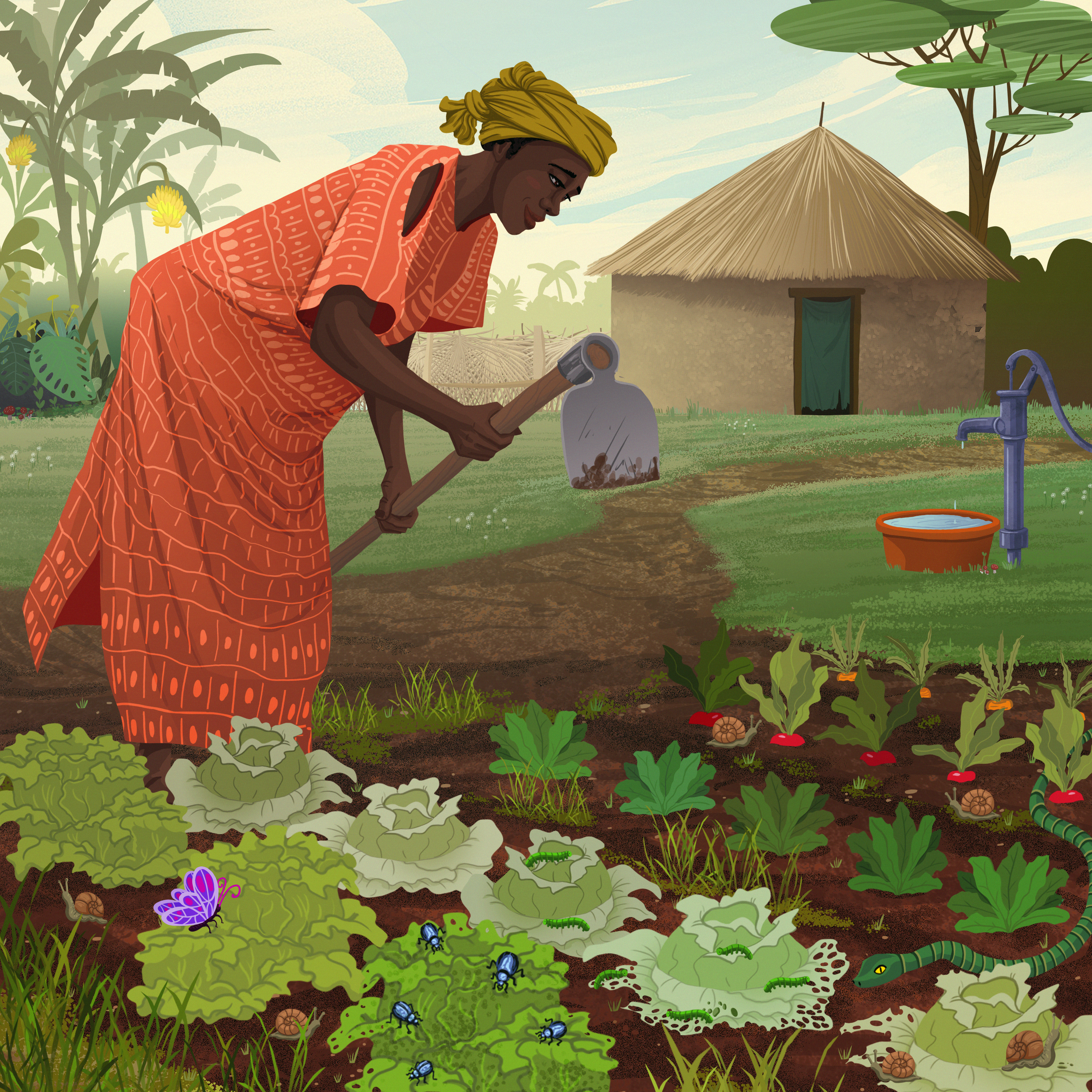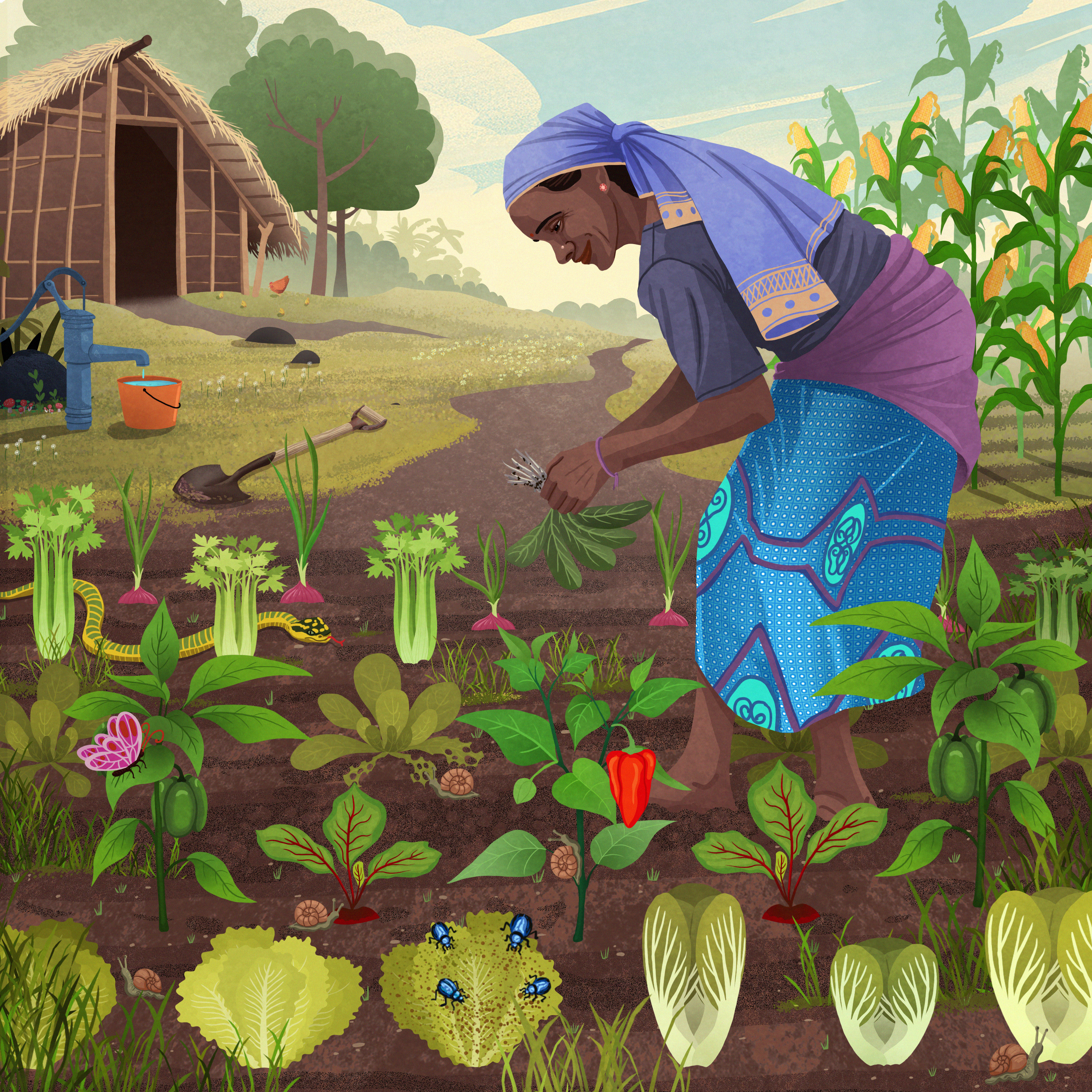Global Child Protection Parenting Curriculum
Year 2, Lesson 9: A Maintained and Healthy Garden: Special Needs Children
Time Needed: 45 minutes
Garden Images:



Index
Teacher Preparation
Introduction
New Ideas
Caregiver Connection
Application/Activity
Reflection
Closing
Resources
Teacher Preparation
Objectives
The caregiver will be able to:
- Hear a story about how a man’s friends take great measures to bring him to Jesus.
- Explain why all children, regardless of disabilities, have precious worth.
- Explore how people in the local community and culture respond to special needs children.
- List positive ways to advocate for and protect children with special needs.
- List local organizations that provide support for special needs children.
Materials
- Chalkboard and chalk
- Three household items (see Preparation)
Preparation
- Read the lesson and reflect on how to teach it wisely.
- Skim previous lesson. Prepare to have a quick review at the beginning of class.
- Choose three household items to bring to the class. One should be useful such as a kitchen tool, the other should be beautiful such as a vase or piece of jewelry and the last should be a drawing by a child. If you don’t have a drawing, create a picture with crayons as if a child created it.
- Make two signs: either one that says “Don’t” and the other that says “Do” or one with a check mark and the other an x mark. See the end of the lesson for these images.
- Make a list of the local support centers caregivers can go to get additional support for special needs children.
Introduction
5 minutes
![]()
Hold up your three chosen items for the caregivers. Look at these three things.
- Which one of these is useful? Accept answers. Most will say the practical item.
- Which one is beautiful? Accept answers. Encourage participants that there is not a right answer. Most will probably say the vase, jewelry, or beautiful item but some may answer one of the other two.
- Turn to a partner and tell them which item you think is valuable and why. Accept all answers.
Perhaps you said the useful item is most valuable because it has purpose. Or maybe you said this item (hold up the beautiful piece) is valuable because it can be sold for money. But what about this third item (hold up the drawing colored by a child)? You may not immediately see value in this image but what if your child made it and it reminded you of them every time you looked at it?
- Would it have value then? Accept responses.
Last week we discussed the way young girls should be valued and protected. Today, we will discuss another group of people in our society who have great value and need protection. This group is children with special needs.
In this lesson, you will:
- Explain why all children, regardless of disabilities, have precious worth.
- Explore how people in the local community and culture respond to special needs children.
- Hear a story about how Jesus values and heals those who come to him.
- List positive ways to advocate for and protect children with special needs.
- List local organizations that provide support for special needs children.
New Ideas
15 minutes
![]()
All children, regardless of their appearance or usefulness, have value. Even those with disabilities who may not appear useful or beautiful are precious because they are made in God’s image. God sees each of these children, even before they are born and loves them just as much as a child who does not have these needs. Like the childlike image I held up, they have value because they show us God in a unique way. None of them should be hidden, rejected or discarded. Instead, we must find ways to protect and care for them.
The World Health Organization estimates there are 1 billion people in the world who live with special needs. Nearly 93 million children under 15 years live with moderate or severe disability. These children require medical, physical, psychological, or intellectual support. Their needs may vary in intensity. For example, one child may have trouble saying certain words correctly while another is unable to speak at all. One child may have the loss of one hand while another may be completely immobile and unable to use any of her limbs. One child may have delay in his thinking abilities while another has no ability to care for herself.
Whether the disability is moderate or severe, the child with special needs faces more than just physical, mental or emotional problems. They face other people’s response to them and their disability.
Turn to another participant and discuss the following question:
- How do people in our community and culture view and respond to children with special needs? Give a few minutes for participants to discuss the question. Come back together and share answers. Consider sharing any of the following answers that are not stated but seem true for your culture.
- They are seen as having less value.
- They are seen as a burden to family and society.
- They are dismissed and ignored.
- They are seen as incapable of education.
- They are seen as unworthy of education.
- They are seen as having special power or gifts.
- They are seen as demon possessed.
- Their family is seen as cursed.
- People think they are not fully human.
Many of these views about special-needs children focus on their lack of value in society. These children may be viewed as an inconvenience or even a curse. But Jesus invites us to see these children in a new way. He asks us to value and protect them because he does. The Bible tells us that every living human has worth—not because they are useful or beautiful but because they are made in God’s image. Our reading today explores how Jesus treated a man who was not valued in his culture. As I read these verses from the book of Luke, found in the New Testament, pay attention to how Jesus values this disabled man and his friends.
Luke 5:17-26
17 One day Jesus was teaching. Pharisees and teachers of the law were sitting there. They had come from every village of Galilee and from Judea and Jerusalem. They heard that the Lord had given Jesus the power to heal the sick. 18 So some men came carrying a man who could not walk. He was lying on a mat. They tried to take him into the house to place him in front of Jesus. 19 They could not find a way to do this because of the crowd. So they went up on the roof. Then they lowered the man on his mat through the opening in the roof tiles. They lowered him into the middle of the crowd, right in front of Jesus.
20 When Jesus saw that they had faith, he spoke to the man. He said, “Friend, your sins are forgiven.”
- Who valued the disabled man? The friends and Jesus.
- How did the disabled man’s friends show they valued him? They worked hard to lower him through the roof tiles.
- Jesus didn’t heal the man’s body right away. Instead, what did he do? He forgave his sins.
Jesus wasn’t as concerned with people’s external abilities or accomplishments as with their heart. Jesus first healed the man’s heart by forgiving him. The religious leaders, however, were only concerned with outward accomplishments. They valued those who understood and obeyed the law. As I read this next part, listen to how Jesus responds to these leaders compared to how he responds to the disabled man.
21 The Pharisees and the teachers of the law began to think, “Who is this fellow who says such an evil thing? Who can forgive sins but God alone?”
22 Jesus knew what they were thinking. So he asked, “Why are you thinking these things in your hearts? 23 Is it easier to say, ‘Your sins are forgiven’? Or to say, ‘Get up and walk’? 24 But I want you to know that the Son of Man has authority on earth to forgive sins.” So he spoke to the man who could not walk. “I tell you,” he said, “get up. Take your mat and go home.” 25 Right away, the man stood up in front of them. He took his mat and went home praising God. 26 Everyone was amazed and gave praise to God. They were filled with wonder. They said, “We have seen unusual things today.”
- How did Jesus respond to the Pharisees or religious leaders? Accept answers. Possible answer may include: he challenged their thoughts and hearts; he showed them his way was better than theirs.
- How did Jesus respond to the disabled man? Accept answers. He forgave him; he healed his body.
Caregiver Connection
5 minutes
![]()
Jesus rewarded the friends who trusted him and made the effort to bring their friend to him. He healed their friend’s heart and body. Jesus invites us to believe in his power too. He wants to reward us when we value and support children with special needs. He will help us when we entrust those who are weak to him.
Some of the weakest members of our society are children with special needs. Families may hide these children and they may not receive the education or help they need. They may be unprotected and even worse, neglected and abused. Let’s explore some of the practical ways we can protect and support them.
- What are some of the resources you know are available for people who have special needs children? Accept ideas.
Discuss some of the specific nearby programs and support available in your own community. Talk to participants about places caregivers with special needs children might go that can help support their families. Possible ideas may include but are not limited to:
- Health clinics
- Religious or community leaders
- Community organizations
- Hospitals
- Caregiver groups
- Early Childhood Development (ECD) centers
- Raise your hand if you know a family with a special needs child.
- Raise your hand if you have a child with special needs. Thank these participants for sharing this with the class.
Just as the disabled man in the story needed friends to bring him to Jesus, every disabled child needs a caregiver to support them. If we don’t have a special needs child but know someone who does, we can support that caregiver when we value their child and give them permission to come to us when they are tired or struggling. We can encourage the caregiver to take care of themselves and when possible, care for the caregiver and family in practical ways.
If you are a caregiver with a special needs child, you must find ways to care for yourself, so you are better prepared to care for your child. Having a child with special needs is an emotional, physical, and psychological challenge to caregivers. According to research, caregivers to disabled children report increased medical problems in their own bodies due to stress and social challenges. They often experience anxiety, depression, and physical exhaustion. They report social rejection that brings feelings of shame, embarrassment, and a desire to hide or reject their own child.
Application/Activity
15 minutes
![]()
Let’s play a simple game to explore some of the ways we do or don’t respond as caregivers to special needs children.
- Look on the signs hanging up on either side of the room. On one side, you see a sign that indicates “don’t” and on the other side, “do” (alternately, you have a sign with an x and a sign with a check).
- I will give you a list of statements about how a caregiver might respond outwardly or inwardly (in your heart) when they are taking care of a special needs child.
- If the statement is something you think a special needs caregiver should not do, move toward the sign that says “Don’t” (or with an x). If the statement is something you think one should do, move toward the sign that says “Do” (or with a check).
- Read items from each list below out of order. Mix up the lists, so you’re not reading only from one list at a time. If helpful, check each off with a pencil as you go.
- Discuss each statement as you go. Ask participants why they chose the “do” or “don’t” signs, especially if people turn toward different signs.
DON’T
- Blame yourself. Tell yourself it’s your fault your child has disabilities, and you are being punished for some sin. After students have turned toward the “don’t” sign, say: No matter what people say, it is not your fault that you have a child with special needs. Environmental toxins, genetic illness, and other issues beyond your control cause these problems. You are not being punished.
- Compare yourself and your child to those who don’t have special needs children.
- Give into the temptation to get angry or harm your child.
- Focus on the ways your child is broken, different or disappoints you.
- Release your anger and frustration on your child because they can’t tell anyone anyway.
DO
- View your special needs child as valuable and worth protecting.
- Choose a safe friend or family member to help relieve you sometimes.
- Choose one simple activity to do for yourself each day. After participants have turned toward the “do” sign, suggest: Think of three things you are grateful for; make your favorite tea; enjoy brushing your child’s hair; eat a favorite piece of fruit slowly; close your eyes and imagine Jesus looking at you with love.
- Find another caregiver with special needs children in the community and meet to support each another.
- Go against the natural anger and frustration you feel when it is difficult. Ask God to give you his patience, wisdom, and kindness for your child.
- Daily bless your child. Imagine Jesus is with you in the room, looking at them with love. Envision they are being filled by his light and love.
- Recognize ways you and your child are learning and growing. Focus on this growth more than your problems.
- Choose a simple game or activity to play once every day with your child. Try to make it the same time each day. This will give your child something to look forward to, help you connect, and focus less on their disability or need.
- Think of one way, each day, your special needs child is a blessing to you and your family. Once participants have turned toward the sign, suggest possible ways their child may be a blessing: Maybe they are gentle; maybe they often smile at you; or maybe their presence encourages you as you perform daily tasks.
After all the statements are read, invite participants to turn to one other person and tell each other one “don’t” and one “do” practice they want to try themselves—whether they have a special needs child or not.
Reflection
4 minutes
![]()
Parenting is difficult, but parenting special needs children is especially challenging. You will likely make mistakes, feel confused and frustrated. But like the friends who brought the man to Jesus, you can bring him your questions, struggles and desires for healing. He is powerful to heal your heart and give you the patience, endurance, and wisdom that you need.
Let’s take a minute to reflect on what we’ve discussed and ask God for wisdom about the following question:
- What is one way you want me to value and care for the special needs children or caregivers in my community?
Closing
1 minute
![]()
In Luke 18:16 Jesus said,
"Let the little children come to me,” … "Don't keep them away. God's kingdom belongs to people like them.”
Jesus says we must become simple and trusting, like children, to participate in his kingdom ways. He invites us to be needy and depend on him. There is no more needy and dependent person in our society than a special needs child. If we allow them, these children can become our greatest teachers. They show us the way to Jesus and call us to focus more on internal values and less on external ones. Special needs children are made in God’s image and precious to him. They are more valuable than a kitchen tool or piece of jewelry. They are the childlike image of God. If we walk with Jesus, we can view special needs children in this way.
![]()

